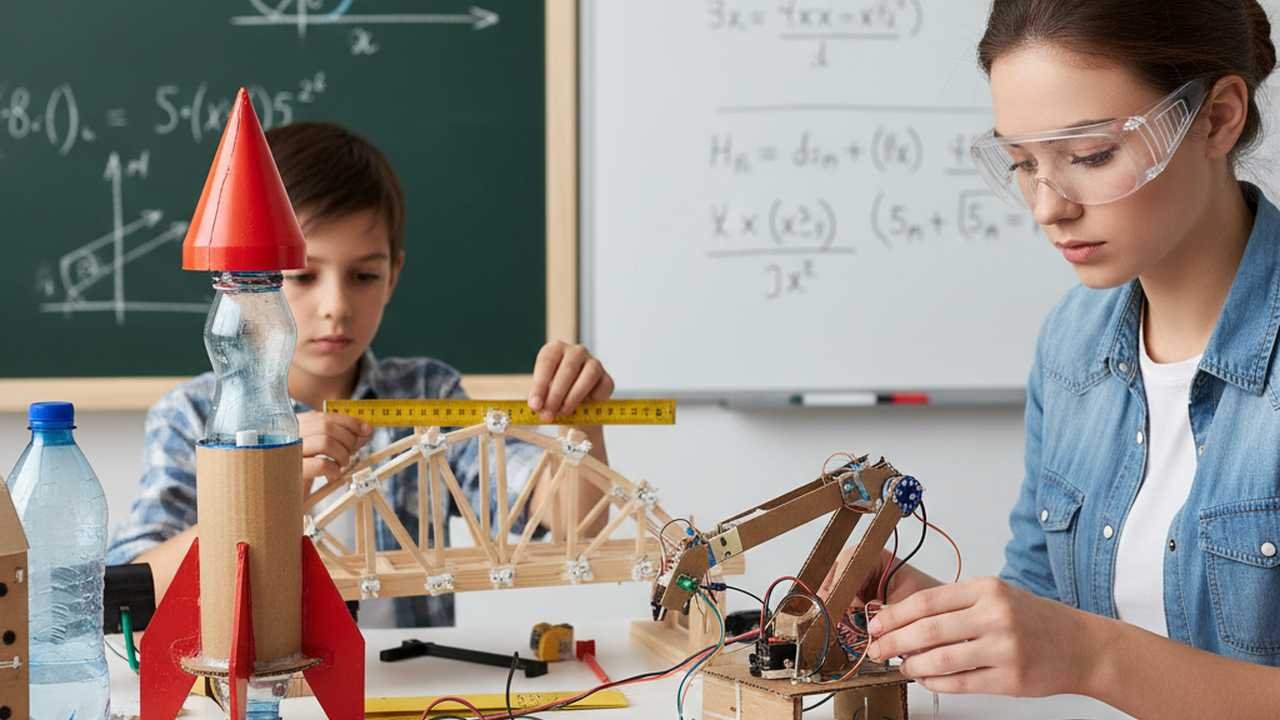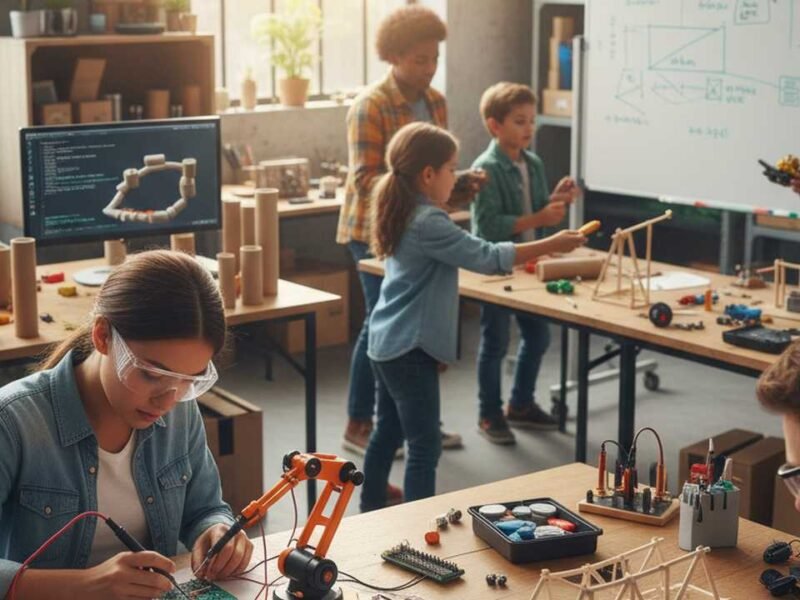Igniting Curiosity Through Hands-On Learning
The world of education is evolving at an unprecedented pace, and traditional classroom settings can no longer fully engage the inquisitive minds of today’s students. Imagine the sparkle in a child’s eyes as they build a miniature bridge out of popsicle sticks, testing its strength and discovering the principles of tension and compression firsthand. This is the essence of non traditional education: a dynamic approach that fuses creativity with logic, making abstract concepts tangible and thrilling. Unlike textbooks, which often reduce math and physics to dull formulas, DIY STEM projects offer a sensory-rich learning experience. Students can feel the weight of a pendulum, hear the hum of a small motor, and witness the precise arc of a trajectory, all while internalizing complex engineering principles. This form of education doesn’t just teach; it sparks wonder, cultivates critical thinking, and creates a visceral connection between theory and real-world application. In a rapidly changing world, those who embrace hands-on experimentation are already a step ahead, harnessing curiosity as the engine of knowledge.
Transforming Math Into a Visual Adventure
Math often suffers from a reputation of being abstract and inaccessible, yet DIY STEM projects transform numbers and equations into living, breathing experiments. Consider a project where students construct a functional catapult from simple household materials. Calculating angles, force, and trajectory is no longer an exercise in rote memorization; it becomes a captivating investigation into how math governs motion. The excitement of adjusting the launch angle and observing the projectile soar creates an immediate feedback loop that reinforces learning. Non traditional education thrives in these moments, providing learners with the opportunity to see algebra and geometry in action, rather than merely on paper. By engaging multiple senses – sight, touch, and even hearing – students build a deeper, more intuitive understanding of mathematical relationships. This approach also encourages iterative thinking, as learners tweak designs, measure outcomes, and refine calculations, fostering a mindset that values experimentation and resilience over memorization.
Exploring Physics Through Interactive Experiments
Physics is often perceived as intimidating, filled with abstract laws and perplexing equations, but DIY STEM projects dismantle this barrier, making the invisible forces of nature palpable. Take, for instance, constructing a simple hovercraft using a balloon and a CD. The moment students release the air and watch the CD glide across the table, the principles of friction, air pressure, and Newton’s laws suddenly spring to life. Through non traditional education, learners develop a tactile comprehension of momentum, gravity, and acceleration, cementing concepts that textbooks alone cannot convey. These experiments cultivate curiosity and perseverance, pushing students to hypothesize, test, and analyze outcomes with excitement and urgency. Beyond theoretical understanding, this hands-on approach teaches the scientific method organically, encouraging students to observe meticulously, record data accurately, and draw evidence-based conclusions, all while experiencing the thrill of discovery firsthand.
Engineering Concepts Made Tangible
Engineering is the bridge between imagination and reality, and DIY STEM projects make that bridge accessible to all learners. Designing and assembling functional structures, vehicles, or circuits provides a concrete context in which abstract engineering concepts like load distribution, energy conversion, and system design are vividly illustrated. Consider a project where students create a small-scale suspension bridge using string, paper, and glue. They can feel the tension in the cables, test the weight-bearing capacity, and witness how design modifications improve stability. Such tactile exploration is the cornerstone of non traditional education, offering students an immersive environment where trial, error, and ingenuity converge. This hands-on methodology not only teaches engineering principles but also cultivates soft skills such as problem-solving, collaboration, and creative thinking, empowering learners to approach challenges with confidence and imagination.
Integrating Technology and Coding Skills
In the digital age, understanding technology is not optional – it is essential. DIY STEM projects often integrate coding and electronics, providing learners with immediate, tangible outcomes from their digital efforts. For example, programming a small robotic arm to pick up and move objects demonstrates automation, precision, and logic in a way that is both engaging and practical. Through non traditional education, students gain firsthand experience with circuits, sensors, and algorithms, while seeing the immediate consequences of their code manifest in real-world actions. This integration of technology not only builds technical proficiency but also reinforces fundamental concepts in math and physics, as learners calculate distances, angles, and forces to optimize their creations. The result is a holistic educational experience that prepares students for a future where interdisciplinary knowledge and adaptability are invaluable assets.
Fostering Teamwork and Collaboration
DIY STEM projects are rarely solitary pursuits; they thrive on collaboration, communication, and shared problem-solving. Working in teams, students divide tasks, debate design strategies, and combine their unique strengths to achieve a common goal. This cooperative environment mirrors real-world engineering and scientific practices, reinforcing social and emotional learning alongside technical skills. Non traditional education leverages these experiences to teach negotiation, leadership, and empathy, all critical competencies in a professional and academic context. Imagine a group of learners constructing a Rube Goldberg machine, where each student is responsible for a specific component. The interdependence of these elements creates a palpable sense of urgency and accountability, as each decision impacts the performance of the entire system. Such projects instill pride, resilience, and the thrill of achieving something collectively, far beyond what traditional individual assignments can offer.
Encouraging Critical Thinking and Problem-Solving
Critical thinking is the heartbeat of innovation, and DIY STEM projects place learners directly at the intersection of challenge and solution. Whether troubleshooting a malfunctioning circuit, recalculating the trajectory of a water rocket, or redesigning a bridge to support more weight, students are constantly engaged in iterative problem-solving. Non traditional education fosters an environment where mistakes are not failures but opportunities for exploration and refinement. By navigating these challenges, learners develop analytical skills, logical reasoning, and creative adaptability. The sensory engagement – seeing, touching, and manipulating materials – creates a feedback-rich environment where abstract theories gain concrete meaning. Each obstacle conquered provides a surge of excitement and a sense of accomplishment, reinforcing the idea that learning is an active, dynamic, and deeply rewarding journey.
Real-World Applications and Career Readiness
DIY STEM projects are more than just classroom exercises – they are gateways to real-world skills and career preparation. Students who engage in hands-on exploration gain practical experience that mirrors professional scenarios in engineering, technology, and scientific research. Non traditional education equips learners with a toolkit of transferable skills, including project management, technical literacy, and collaborative problem-solving, all highly valued in today’s job market. For example, constructing a solar-powered vehicle introduces principles of renewable energy, efficiency, and design optimization, all directly relevant to careers in green technology and engineering. By linking theory to tangible outcomes, students not only deepen their understanding but also gain a competitive edge, positioning themselves as proactive, skilled, and adaptable individuals ready to thrive in an ever-evolving professional landscape.
Creating Lifelong Learners and Innovators
The ultimate goal of DIY STEM projects is to cultivate lifelong learners who are inherently curious, resilient, and innovative. By engaging with math, physics, and engineering concepts in a hands-on, sensory-rich environment, students develop a mindset that embraces exploration and continuous learning. Non traditional education encourages learners to seek challenges, experiment boldly, and apply their knowledge creatively across domains. These experiences ignite a passion for discovery that extends beyond the classroom, motivating students to pursue new technologies, invent solutions, and approach problems with confidence and ingenuity. The sense of urgency and excitement generated by these projects instills a fear of missing out (FOMO) on the thrill of discovery, inspiring learners to dive deeper, experiment more, and never settle for passive consumption of knowledge. The result is a generation of thinkers, makers, and innovators who carry the excitement of learning into every aspect of their lives.
Taking Action: Empower Your Child’s Future Today
The time to embrace non traditional education is now. Parents, educators, and learners alike cannot afford to wait while opportunities for hands-on STEM exploration pass by. DIY projects unlock the full spectrum of learning – math, physics, engineering, and beyond – through immersive, sensory-rich experiences that textbooks cannot replicate. By integrating these activities into daily learning, students gain a powerful edge in knowledge, creativity, and critical thinking. Trusted industry leaders and verified programs offer structured kits, responsive customer service, secure transactions, and documented success stories from thousands of users who have witnessed tangible academic improvements. Don’t let your child or students miss the chance to engage in this transformative approach. Explore the opportunities at STEM Kits and start building, experimenting, and innovating today – because the future belongs to those who act decisively and learn by doing.

